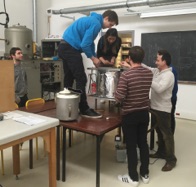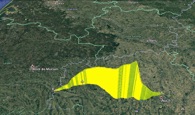Balloon project
Ever since Victor Hess' discovery of Cosmic Rays a century ago, new windows to the Universe were opened with the help of stratospheric balloons – either through genuine discoveries or by using balloon platforms as technology test beds for new satellite missions. At a fraction of the cost and time requirement of orbital missions, balloon programs continue to be extremely valuable for the development of new instruments and technologies for space science. Beyond their role as science pioneers and technology pathfinders, balloon missions are highly beneficial for preparing future actors in space science.
As a part of their M2TSI, students run a regular high-altitude balloon program going through an entire cycle of a small mission. In small teams they tackle the various aspects of a space mission: mechanical, thermal, electric architecture; attitude control and navigation (passive), power generation and management, on-board data handling; TM/TC; payload operation and data acquisition, project management, product assurance and development). After having chosen one or several science objectives, the students design, build and test the payload. Through an adequate project management and planning – which is also handled by a team of students – the project goes through the various phases and reviews of a space project. By the end of the first semester, the balloon payload is then be launched from Aire-sur-l'Adour in collaboration with the balloon division of CNES.
The educational "hands-on" value is equivalent to the nano-satellite projects that are lead by many Universities. The non-neglectable difference is that the M2TSI students will see more than only a short sequence in the lifecycle of a space project, as the phases of the M2TSI balloon missions will be conducted within less than a year. This is a unique opportunity for a student to become familiar with all aspects of a space project - while making him aware of the outstanding potential of stratospheric balloons. of stratospheric balloons.







